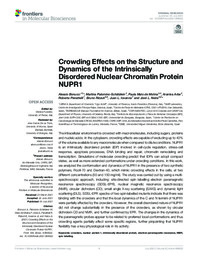Por favor, use este identificador para citar o enlazar este ítem:
https://hdl.handle.net/11000/37783Registro completo de metadatos
| Campo DC | Valor | Lengua/Idioma |
|---|---|---|
| dc.contributor.author | Bonucci, Alessio | - |
| dc.contributor.author | Palomino-Schätzlein, Martina | - |
| dc.contributor.author | Malo de Molina, Paula | - |
| dc.contributor.author | Arbe, Arantxa | - |
| dc.contributor.author | Pierattelli, Roberta | - |
| dc.contributor.author | Rizzuti, Bruno | - |
| dc.contributor.author | Iovanna, Juan L. | - |
| dc.contributor.author | Neira, José L. | - |
| dc.contributor.other | Departamentos de la UMH::Agroquímica y Medio Ambiente | es_ES |
| dc.date.accessioned | 2025-11-03T11:45:09Z | - |
| dc.date.available | 2025-11-03T11:45:09Z | - |
| dc.date.created | 2021 | - |
| dc.identifier.citation | Frontiers in Molecular Biosciences | es_ES |
| dc.identifier.issn | 2296-889X | - |
| dc.identifier.uri | https://hdl.handle.net/11000/37783 | - |
| dc.description.abstract | The intracellular environment is crowded with macromolecules, including sugars, proteins and nucleic acids. In the cytoplasm, crowding effects are capable of excluding up to 40% of the volume available to any macromolecule when compared to dilute conditions. NUPR1 is an intrinsically disordered protein (IDP) involved in cell-cycle regulation, stress-cell response, apoptosis processes, DNA binding and repair, chromatin remodeling and transcription. Simulations of molecular crowding predict that IDPs can adopt compact states, as well as more extended conformations under crowding conditions. In this work, we analyzed the conformation and dynamics of NUPR1 in the presence of two synthetic polymers, Ficoll-70 and Dextran-40, which mimic crowding effects in the cells, at two different concentrations (50 and 150 mg/ml). The study was carried out by using a multi-spectroscopic approach, including: site-directed spin labelling electron paramagnetic resonance spectroscopy (SDSL-EPR), nuclear magnetic resonance spectroscopy (NMR), circular dichroism (CD), small angle X-ray scattering (SAXS) and dynamic light scattering (DLS). SDSL-EPR spectra of two spin-labelled mutants indicate that there was binding with the crowders and that the local dynamics of the C and N termini of NUPR1 were partially affected by the crowders. However, the overall disordered nature of NUPR1 did not change substantially in the presence of the crowders, as shown by circular dichroism CD and NMR, and further confirmed by EPR. The changes in the dynamics of the paramagnetic probes appear to be related to preferred local conformations and thus crowding agents partially affect some specific regions, further pinpointing that NUPR1 flexibility has a key physiological role in its activity. | es_ES |
| dc.format | application/pdf | es_ES |
| dc.format.extent | 14 | es_ES |
| dc.language.iso | eng | es_ES |
| dc.publisher | Frontiers Media | es_ES |
| dc.relation.ispartofseries | 8 | es_ES |
| dc.rights | info:eu-repo/semantics/openAccess | es_ES |
| dc.rights | Attribution-NonCommercial-NoDerivatives 4.0 Internacional | * |
| dc.rights.uri | http://creativecommons.org/licenses/by-nc-nd/4.0/ | * |
| dc.subject | Crowders | es_ES |
| dc.subject | Nuclear protein 1 | es_ES |
| dc.subject | Intrinsically disordered protein | es_ES |
| dc.subject | Electron paramagnetic resonance | es_ES |
| dc.subject | NMR | es_ES |
| dc.subject | Spin labelling | es_ES |
| dc.subject.other | CDU::5 - Ciencias puras y naturales | es_ES |
| dc.title | Crowding Effects on the Structure and Dynamics of the Intrinsically Disordered Nuclear Chromatin Protein NUPR1 | es_ES |
| dc.type | info:eu-repo/semantics/article | es_ES |
| dc.relation.publisherversion | https://doi.org/10.3389/fmolb.2021.684622 | es_ES |

Ver/Abrir:
fmolb-08-684622.pdf
1,97 MB
Adobe PDF
Compartir:
 La licencia se describe como: Atribución-NonComercial-NoDerivada 4.0 Internacional.
La licencia se describe como: Atribución-NonComercial-NoDerivada 4.0 Internacional.
.png)